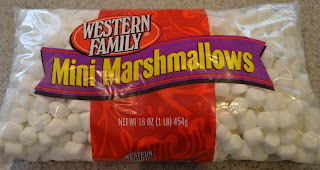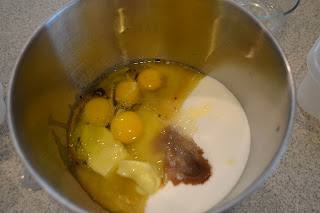Anytime is a great time to make a delicious raspberry pie, but when you add a few blueberries atop the whipped cream, you have an All-American Dessert perfect for the 4th of July!
Let's start with the crust.
You will need:
- 1/4 c. cold water, (with 1 ice cube in it)
- 1 egg
- 1 tbsp. vinegar
- 2 1/2 c. flour
- 1 c. shortening
- 1 tsp. salt
Crust - Step 1
(Preheat the oven to 400 degrees F.)
Add all the liquid ingredients together in a small bowl. Stir well with a fork. Let sit (must have the ice cube) while you gather the rest of the ingredients.
Crust - Step 2
In a medium-sized mixing bowl, add only 2 cups of the flour and the teaspoon of salt. Stir together. Then measure 1 cup of shortening and add to the flour mixture. You will be cutting the shortening into the flour mixture until the shortening pieces are about pea-size.
Note: I use my Kitchenaid mixer, but you can also use a pastry blender or two butter knives.
This is the bowl before cutting in the shortening.
This is the bowl when the shortening is in sufficiently small pieces.
Crust - Step 3
Remove the icecube from your wet ingredients and add the liquid to your flour/shortening bowl and stir together until just moist. DO NOT overmix! The secret to flaky pie crust lies in not over-working the dough.
Once the dough is hanging together, form into two, fist-sized balls. These will be your pie shells.
Crust - Step 4
When we were making the pie dough, we only added 2 cups of the 2 1/2 cups of flour that the recipe called for. That's because during the crust rolling-out process you want to USE PLENTY OF FLOUR. I like to roll out my crusts on a Tupperware plastic sheet, but the counter top works fine too. For each ball of dough I use approx. 1/2 cup of flour on my surface. Then I roll the dough ball around in the flour, and begin rolling it out with my rolling pin.
As I'm rolling, I sprinkle on more flour as needed, being careful not to allow the crust to stick to my rolling pin. (Yeah. There's nothing like weilding a rolling pin to make one feel like a real woman!)
There's not rush to rolling out the crust. Go slowly, rolling out the dough into a rough circle. I like to roll my crust until I can just read the lines of my Tupperware sheet through the crust -- that's when I know that I've rolled it thin enough.
If your crust doesn't cooperate, and sticks to everything, gather up all the dough, sprinkle more flour on your surface, and start that crust again. Note: I don't roll out a piece of dough more than twice. It's just too tough after that, so I start over from step one if roll-out number two goes kaput.
Crust - Step 5
Now comes the tricky part -- getting your dough from the rolling surface to your pie pan. I use a metal spatula and carefully go under the edges of my dough. Then I ever-so-carefully fold the crust in half, carefully using the spatula to lift the center of the crust off the surface without tearing. Once the crust is completely unstuck, I carefully lift it into my pie pan and then un-fold it.
I mend any tears in the dough by overlapping them and pressing them together. It's also important to firmly press the dough into the bottom and edges of the pie pan. As you can see in the picture below, I like a lot of crust to work with around the top, so I fold the dough under itself around the rim, pressing as I go. Once the dough is firmly pressed into the pan, and I've got plenty of dough around the top, I trip off the excess with a butter knife.
Crust - Step 6
Now you're ready to bake your pie crust. Place it on the center rack of an oven that's preheated to 400 degrees F. It bakes for approximately 15 minutes or until a light, golden brown. (Time varies depending your individual oven.)
Once the crust is done, remove it from the oven and let it cool completely.
Note: This recipe makes two generous 9" pie crusts. You'll also have some dough leftover. I like to scrunch in into a ball, put it in a sandwich bag, and freeze it to use later as the top of a chicken-pot-pie.
Once your pie shells are out of the oven, you can start working on the raspberry pie filling.
You will need:
- 1, 3-oz. box of raspberry flavored gelatin
- 1 c. sugar
- 1/4 tsp. salt
- 1/4 c. cornstarch (a tad more if fruit is from frozen)
- 2 c. water (1 3/4 c. if fruit is frozen)
- 2 Tbsp. lemon juice
- 3 to 4 c. fresh raspberries / 4 c. frozen raspberries
Filling - Step 1
In a medium saucepan, add dry ingredients (gelatin, sugar, salt, cornstarch) and stir well.
Filling - Step 2
Next, add 2 cups of water if using fresh raspberries, or 1 3/4 cups of water if raspberries are frozen and two tablespoons of lemon juice.
Filling - Step 3
Cook mixture on medium-high heat, stirring constantly until it comes to a full boil. Remove from heat, and let filling cool slightly.
Filling - Step 4
If using fresh berries, let gelatin mixture cool for at least 30 minutes before adding berries. For frozen berries, let the gelatin mixture cool for 10 minutes or so, and add berries to the saucepan, stirring well.
Once berries are combined with gelatin mixture, divide the filling evenly into your two pie shells and refrigerate for approximately four hours.
Topping
Only real whipping cream for an all-American pie.
Before whipping cream, place the bowl, beaters, and rubber scraper in the freezer for at least 5 minutes -- this makes for no-fail whipped cream every time!
In your chilled bowl, dump in a 1/2 pint (8 oz.) of heavy whipping cream and 1/2 cup of granulated sugar. Beat with chilled beaters on medium-high until the cream is stiff and forms peaks that are firm.
Divide whipped cream onto pies and garnish with fresh blueberries for a red, white, and blue dessert.
Note: You can make this pie with a variety of fresh or frozen fruits. We also like:
strawberries and strawberry flavored gelatin
peaches and peach flavored gelatin.
Hope you enjoy it!




















































